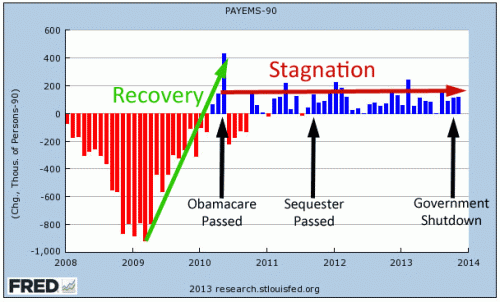Trade and The World's Most Misunderstood Accounting Identity: Y=C+I+G+X-M
Repeat after me: Y=C+I+G+X-M is an accounting rule. It does not explain anything about the economy. It is as useful to telling us anything interesting about the economy as the equation biomass=plants+animals+bacteria tells us anything about the ecosystem.
Which is why this kind of article in the press makes me crazy (emphasis added)
The U.S. trade gap narrowed in April as the effects of a West Coast port slowdown faded, easing one of the biggest drags on economic growth during the opening months of the year....
This year’s volatile import and export figures worked out to an overall drag on the economy in the opening months of 2015....
A surge in imports and falling exports subtracted 1.9 percentage points from the headline figure. As measured by GDP, exports are a positive for economic growth, while imports are a negative...
“The huge drag on GDP from trade in Q1 will almost certainly not be repeated in Q2,†said Jim O’Sullivan, chief U.S. economist at High Frequency Economics.
Here is the logic. The GDP is calculated by adding Consumer spending + Industrial spending + Government spending + eXports and then subtracting iMports. Because imports are subtracted in the GDP equation, they look to the layman like they shrink the economy. How do we grow the economy? Why, let's reduce that number that is subtracted! But this is wrong. Totally wrong. I have tried many times to explain this, but let me see if I can work by analogy.
Let's say we wanted an equation to count the amount of clothing we owned. To make things simple, let's say we are only concerned with the total of Shirts, Pants, and Underwear. Most of our clothes are in the closet, so we say our clothes are equal to the S+P+U we count in our closet. But wait, we may have Loaned clothes to other people. Those are not in our closet but should count. So now clothes = S+P+U+L. But we may also have borrowed clothes. Some of those clothes we counted in the closet may be Borrowed and thus not actually ours, so we need to back these out. Our final equation is clothes = S+P+U+L-B. Look familiar?
Let's go further. Let's say that we want to increase our number of clothes. We want wardrobe growth! Well, it looks like those borrowed clothes are a "drag" on our wardrobe size. If we get rid of the borrowed clothes, that negative B term will get smaller and our wardrobe has to get larger, right?
Wrong. Remember, like the GDP equation, our wardrobe size equation is just an accounting identity. The negative B term was put in to account for the fact that some of the clothes we counted in S+P+U in the closet were not actually ours. But if we decrease B, say by returning our friend's shirt, the S term will go down by the exact same amount. Sure, B goes down, but so do the number of shirts we count in the closet. So focusing on the B term gets us nowhere.
But it is actually worse than that, because focusing on reducing B makes us worse off. If B rises, our wardrobe is no larger, but we get the use of all of those other pieces of clothing. Our owned wardrobe may not be any larger but we get access to more choices and clothing possibilities. When we drive B down to zero, our wardrobe is no larger and we are worse off with fewer choices.
Returning to the economy, I don't want to say that it's impossible for increases in imports to drag the economy. For example, if oil prices rise, the imports number measured in dollars will likely rise, and the economy will likely be worse off as we have to give up buying other things to continue to buy the oil we need. But, absent major price changes, drops in exports more likely just mirror drops in C+I+G. If consumers are hurting, they spend less on everything, including imported goods. At the end of the day, none of these numbers (Mr. Keynes, are you listening?) are independent variables.
Postscript: By the way, the trade deficit is a mirage in another way - it looks at only a subset of trans-national financial transactions. The flow of dollars is (mostly) always in balance. So if we are net sending dollars overseas when trading hard goods, the dollars come back in foreign purchases of investments and financial goods (which aren't included in the trade numbers). Saying we have a trade deficit is the same as saying we have a net investment surplus. For you physical scientists out there, measuring the trade deficit is like drawing your box around the process wrong such that you miss some of the forces.
If you really want to know our trade problem, it's not the trade deficit per se, but the fact that the funds coming back via investments are largely invested in value-destroying government debt rather than productive investments.


